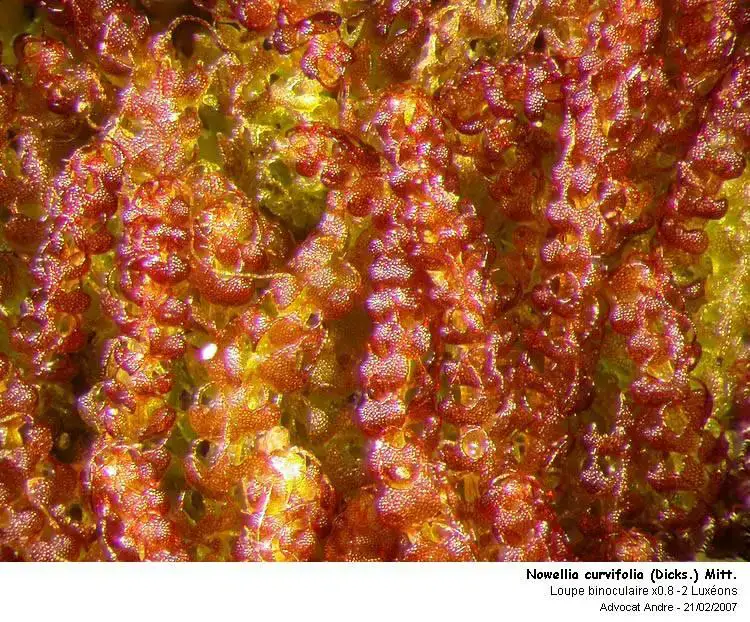
Nowellia-curvifolia-AH-231.jpg from: https://sites.cortland.edu/bryophytes/field-guide/liverworts/nowellia-curvifolia/
Introduction
The world of mosses is a fascinating one, filled with tiny, unassuming plants that often go unnoticed by the casual observer. Among these diminutive wonders is the Nowellia curvifolia (Dicks.) Mitt.

Nowellia-curvifolia-Dicks-Mitt-A-Part-of-plant-dorsal-view-C-Tips-of-gemmiparous.png from: https://www.researchgate.net/figure/Nowellia-curvifolia-Dicks-Mitt-A-Part-of-plant-dorsal-view-C-Tips-of-gemmiparous_fig13_357776052
, a member of the Cephaloziaceae family, commonly known as Nowellia. This moss may be small, but it plays a crucial role in the ecosystems it inhabits, and its unique characteristics make it a captivating subject for enthusiasts.
Background
Before delving into the specifics of Nowellia curvifolia, it’s essential to understand the broader context of mosses. These ancient plants belong to the Marchantiophyta division and the Jungermanniopsida class, which encompasses liverworts and other bryophytes. Mosses are non-vascular plants, meaning they lack the specialized tissues found in larger plants for transporting water and nutrients. Despite their diminutive size, mosses are incredibly resilient and can thrive in a wide range of environments.
Main Content
Morphology and Identification
Nowellia curvifolia is a small, creeping moss that forms dense mats or cushions. Its stems are slender and irregularly branched, with leaves that are curved and overlapping. The leaves are typically ovate to lanceolate in shape, with a distinctive curved or falcate appearance. The color of the moss can range from yellowish-green to brownish-green, depending on its environment and growth stage.
One of the key identifying features of Nowellia curvifolia is the presence of underleaves, which are small, scale-like structures found on the underside of the stem. These underleaves are bifid (divided into two lobes) and help distinguish this species from other mosses in the same family.
Global Distribution and Habitat
Nowellia curvifolia has a widespread distribution, occurring on various continents, including Europe, Asia, North America, and South America. It is particularly common in temperate regions and can be found in a variety of habitats, such as moist forests, shaded rock crevices, and damp soil.
This moss thrives in cool, humid environments and is often found growing on decaying logs, stumps, or the base of trees. It prefers acidic substrates and is commonly associated with coniferous forests, where it can form extensive mats on the forest floor.
Ecological Roles and Adaptations
Despite its small size, Nowellia curvifolia plays a vital role in its ecosystem. Like other mosses, it helps to retain moisture in the soil and provides a microhabitat for various invertebrates, such as insects and microorganisms. Additionally, mosses like

212139.jpg from: https://inpn.mnhn.fr/espece/cd_nom/6596

2876564.jpg from: https://waarnemingen.be/species/17763/

3690_Nowellia_curvifolia_2015_04_16_4705.jpg from: https://www.bryo.cz/index.php?p=mechorosty_foto&site=default&gallery=nowellia_curvifolia&id=3690
Nowellia contribute to the cycling of nutrients in the ecosystem by absorbing minerals from the surrounding environment.
One of the remarkable adaptations of Nowellia curvifolia is its ability to survive periods of desiccation. When conditions become dry, the moss can enter a state of dormancy, curling up its leaves and slowing down its metabolic processes. Once moisture returns, the moss can quickly rehydrate and resume its growth and photosynthetic activities.

post-25-1172518031.jpg from: https://forum.mikroscopia.com/topic/5643-nowellia-curvifolia-dicks-mitt/
Case Studies/Examples
In a study conducted in the Pacific Northwest region of North America, researchers found that Nowellia curvifolia played a crucial role in the regeneration of coniferous forests after disturbances such as logging or wildfires. The moss’s ability to quickly colonize disturbed areas and create a moist, nutrient-rich environment facilitated the establishment of tree seedlings and other plant species.
Technical Table

Plagiochila-hyalodermica-Grolle-MLSo-1-A-portion-of-plant-in-dorsal-view-2-The_Q640.jpg from: https://www.researchgate.net/figure/25-Nowellia-curvifolia-Dicks-Mitt-1-A-portion-of-the-plant-in-ventral-view_fig1_274049055

850404.jpg from: https://www.bio-forum.pl/messages/3280/850402.html

Langfliksmossa-Skaralid-2017.jpg from: https://webbapp.signalarter.se/mossor-signalarter/langfliksmossa-nowellia-curvifolia/
| Characteristic | Description |
|---|---|
| Scientific Name | Nowellia curvifolia (Dicks.) Mitt. |
| Family | Cephaloziaceae |
| Common Name | Nowellia |
| Growth Form | Creeping, mat-forming |
| Leaf Shape | Ovate to lanceolate, curved or falcate |
| Underleaves | Present, bifid (divided into two lobes) |
| Color | Yellowish-green to brownish-green |
| Habitat | Moist forests, shaded rock crevices, damp soil |
| Distribution | Europe, Asia, North America, South America |
| Ecological Role | Moisture retention, microhabitat, nutrient cycling |
| Adaptations | Desiccation tolerance, dormancy |
Conclusion
The Nowellia curvifolia (Dicks.) Mitt., or Nowellia, may be small in stature, but its impact on the ecosystems it inhabits is significant. From providing a microhabitat for countless organisms to facilitating forest regeneration, this unassuming moss plays a vital role in the intricate web of life. As you explore the fascinating world of mosses, take a moment to appreciate the beauty and resilience of these ancient plants, and ponder the question: What other wonders might be hidden in the tiny, overlooked corners of our natural world?